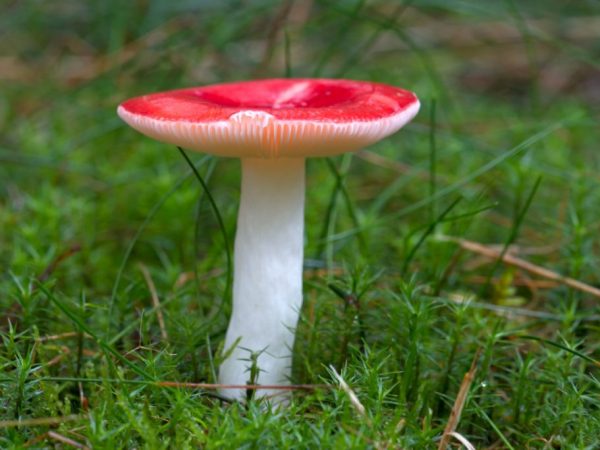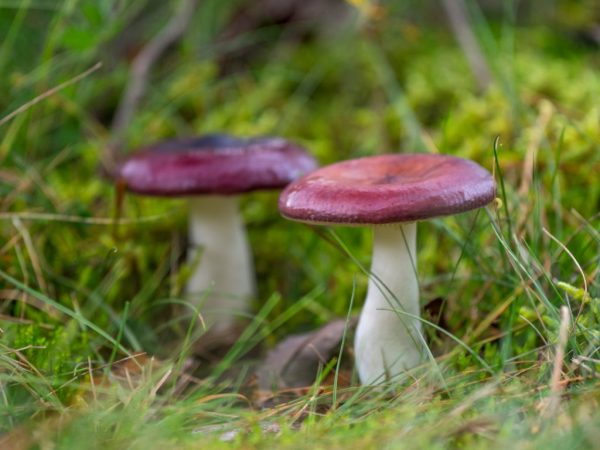Bruise mushrooms
Russula (bruise mushrooms) are the most popular mushrooms in the forests. They got their name due to the possibility of eating raw. However, they are edible and inedible.

Bruise mushrooms
Description of appearance
Sinyavka mushroom - the owner of a hat with a diameter of 5-12 cm with a fleshy pulp and a semicircular shape. Over time, its surface levels out and becomes flat. The edge of the cap is wavy, occasionally with scars. The color is cherry, brown, gray, yellow. The plates are thick and adherent, white and yellow.
The color of the leg is white. It is straight, but bent at the base and dense. Over time, it becomes hollow and becomes gray-brown in color.
In a young bruise, the flesh is white and fresh, while in the old it has a fruity aroma, but at the same time it becomes pungent.
Representatives of the genus grow in coniferous and mixed forests on soils with a high calcium content.
Views
To understand which russula is edible and which is inedible, it is imperative to know the description of the main species of this genus.
Edible:
- White load: bears fruit between summer and autumn. Found in coniferous and mixed forests. The cap is usually white, rarely with yellowish spots. It is convex and funnel-shaped. The leg is low, narrow at the bottom, white or brown.
- Russula yellow: grows in birch and birch-pine forests. Appears in summer and autumn. Young specimens have a yellowish hemispherical cap. As it grows, it becomes flat. Diameter - about 5-10 cm. The skin along the edge of the cap tends to peel off. The leg is white, the plates are at first the same color, but with growth they acquire light yellow and grayish shades. The species is edible, the pulp has a sweet taste.
- Blue russula: lives in coniferous forests. A hat with a diameter of 3-10 cm with a bluish tint. The leg is white, up to 3-5 cm high.
- Green russula: grows in coniferous and deciduous forests. The cap is yellowish-green, flat, about 10 cm in diameter. The mushroom is not beautiful in appearance, but it has an excellent taste. It is eaten in salted, fried and boiled form.
It is easy to confuse a green russula with a pale toadstool. Therefore, when picking mushrooms, you should be careful to avoid poisoning.
Inedible:
- Birch russula: this variety grows next to birch roots. Appears from early summer to late autumn.
- Red russula: found in pine forests. Appears from July to September. The diameter of the cap is up to 6 cm, it is flat-convex, reddish. Delicious and aromatic.
- Pink russula: also grows in pine forests between July and September. The cap is convex in young individuals, later it becomes flat. Has a pinkish tint. Bitter to taste.
Irina Selyutina (Biologist):
There are many types of russula and it will not be possible to distinguish them, let's say "by eye". Only the study of spore powder in laboratory conditions will help to accurately determine the species of russula. And all because these mushrooms have the ability to change the color of their caps depending on age and habitat conditions.Due to the fact that the flesh of russules is white, in some places in Russia they are called "whites", despite the different color of the caps.
Most mushroom pickers value russula with blue, green and yellow hats. Many years of practical experience in harvesting has shown that these mushrooms never taste bitter and they are less brittle, i.e. they can be brought home with great success.
Attention! There are never tuberous thickenings, "skirts" or scales on the stem of the russula. She is always flat and white.
Beneficial features
Sinyavka, or russula, is a low-calorie mushroom (19 kcal per 100 g), but it also has good nutritional properties. Due to its low calorie content and high chitin content, it is advised to eat it to cleanse the intestines.

Mushrooms have antibacterial properties
The flesh of the mushroom is brittle, so it is difficult to bring it to its destination as a whole. Bruises contain russulin, which helps dairy products to curl up. This feature is in demand for making cheeses.
Also in the cells of the fungus there is lecithin, which helps to avoid deposits of cholesterol in the body. Thanks to this substance and low calorie content, russula help in the fight against excess weight.
Representatives of the genus are also used to combat diseases of the gastrointestinal tract, prevent the appearance of blood clots, as an antibacterial agent, to feed the body with vitamins PP and B2.
Contraindications
It is possible to confuse an edible mushroom with a poisonous one. Mushrooms with pungent pulp are inedible and often toxic. When eating them, there is a possibility of damage to the mucous membrane, which will lead to nausea and vomiting.
Russulas are contraindicated for people suffering from ulcers or heart disease: they are difficult to digest. They should not be eaten in large quantities, even by people without health problems. The dosage should be less than 150 g at a time.
They are allowed to be eaten only upon reaching the age of 7.
Application
Sinyavka mushrooms are widely used both in the preparation of dishes and in the creation of medicinal preparations.
In cooking
So that the useful components do not succumb to destruction under the influence of high temperatures, the mushrooms can simply be poured with boiling water, salt, and left to brew for 15 minutes. Only after that do they perform any actions with them.
The broth after russula is used to make soup.
Irina Selyutina (Biologist):
Russula species whose pulp does not have a pungent taste are commonly used for cooking. Species with pungent pulp are usually salted. Before that, any russula is soaked or boiled. For russula, the hot method of salting is considered preferable - first, boiling takes place for about 30 minutes, and only then is the actual salting. In this case, russula are laid out in jars, sprinkled with salt with the obligatory addition of garlic, allspice, dill, blackcurrant leaf. Otherwise, the taste simply will not be - they simply do not have it.
Did you know? Russula easily give up salt when soaked. Therefore, even heavily salted mushrooms can be kept in water for 1 hour and they can be used for their intended purpose: fry, cook soup. They almost do not differ from fresh mushrooms in taste.
In medicine
The content of medicinal components in the composition of these mushrooms is small. In this case, russula is used for the prevention and cleansing of the gastrointestinal tract (in particular the intestines), accelerating metabolism, blood vessels, lowering cholesterol and blood sugar.
Russula are taken as food to thin the blood and as a prophylaxis for venous thrombosis. The broth is used to relieve signs of poisoning, diarrhea, and also as a diuretic. An infusion of dried russula is advised for sclerosis, heart problems. Mushroom compresses help eliminate abscesses.
Raw mushroom gruel is used to remove corns and dead skin particles. The mushroom juice is able to rejuvenate, reduce the severity of pigmentation, make the skin soft and elastic.
Conclusion
The russula have a pleasant taste and will be a wonderful decoration for every table and ordinary, daily and festive. They have beneficial properties due to the content of active ingredients in the composition. Bruising helps prevent blood clots from forming.



